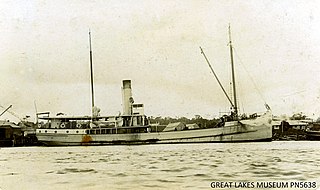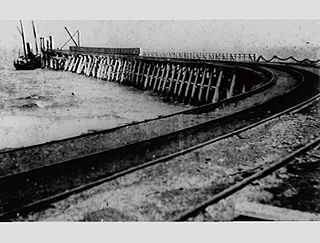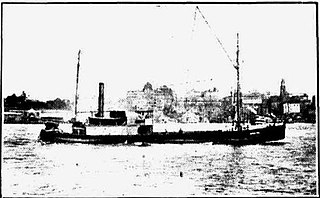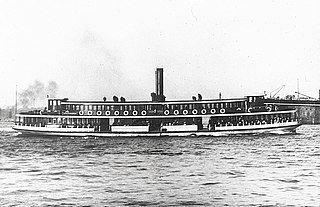
Booderee National Park and Botanic Gardens, formerly Jervis Bay National Park and Jervis Bay Botanic Gardens, are located in the Jervis Bay Territory of Australia. The reserve is composed of two sections:

Bellambi is a suburb of Wollongong in the Illawarra region of New South Wales, Australia. It has a railway station on the NSW TrainLink South Coast Line.
The Advance was a composite schooner built in 1874 at Auckland, New Zealand, that was wrecked when she drifted onto rocks at Henrys Head, Botany Bay, New South Wales, Australia, on 12 June 1902, whilst carrying ballast between Wollongong and Newcastle, New South Wales.
Aeolus was a wooden ketch built in 1850 at Pyrmont, New South Wales, Australia. She was carrying timber to Sydney, New South Wales, when she was lost at Hole in the Wall, Jervis Bay, New South Wales, on 24 October 1867. The wreck has not been located, but its approximate position is 35.134648°S 150.745874°E.

The Comboyne was a wooden screw steamer built in 1911 at Tuncurry, that was wrecked when it struck an object whilst carrying timber to Wollongong and was lost at approximately 1 mile (1.6 km) off Bass Point, Shellharbour, New South Wales on 27 November 1920.

The Narara was a wooden carvel screw steamer built in 1900 at Jervis Bay, that was wrecked when it sprang a leak while carrying general cargo between Sydney and the Hawkesbury River and was lost at 2 ml SE off Little Reef Newport near, Barranjoey, New South Wales on 29 May 1909. The vessel commenced her runs from Sydney Harbour to the Hawkesbury River in January 1900 and continued on this run till the time of her final 1909 sinking. During 1903 the vessel was burned to the water line and sank at its mooring only to be refloated and rebuilt and started back on the same run.

The Koonya was a wood carvel screw steamer built in 1887 at Hobart, that was wrecked when it stuck the shore at Doboy reef whilst carrying passengers & cargo between Moruya and Sydney and was lost off Cronulla Beach, Port Hacking, New South Wales on 25 January 1898.

Koraaga was a Castle-class steel-hulled trawler built in 1914 by Smith's Dock Company, South Bank, Middlesbrough. She was requisitioned as an auxiliary minesweeper operated by the Royal Australian Navy (RAN) in October 1917 for minesweeping duties during World War I, but she was never commissioned. Koraaga returned to be operated commercially as a fishing trawler until she wrecked when she struck a reef off Bass Point whilst carrying returning to Sydney. She was refloated on the tide after having becoming stranded and drifted till she was finally lost five miles (8.0 km) east of Black Head, Gerringong on 10 September 1931.

The Merksworth was an iron steamer screw built in 1874 at, Paisley, that was wrecked when it swamped whilst carrying coal between Newcastle and Sydney and was lost off Stockton Beach on 7 May 1898.

Kuramia was a "K-class" ferry on Sydney Harbour. Commissioned in 1914, the timber-hulled steamer was built for Sydney Ferries Limited during the early twentieth boom in cross-harbour ferry travel. At 353 tons, she was the largest wooden ferry on Sydney Harbour.

The Nimbin was a steel screw steamer built in 1927 at Copenhagen, that was the first motor vessel placed into the New South Wales coastal trade. It was owned and operated by the North Coast Steam Navigation Company and was the first Australian registered merchant ship to be lost during World War II when it struck a mine laid by the German auxiliary cruiser Pinguin. The Nimbin was on its way from Coffs Harbour to its home port, Sydney, with a cargo of bundled three-ply timber and a cargo of pigs. One third of the ship was blown away and it sank in three minutes. Seven men were killed. The remaining thirteen clung to bundles of plywood. Some hours later an air force plane from RAAF Base Rathmines saw the survivors and directed the coastal ship SS Bonalbo to the scene to retrieve them.

SS Pericles was a UK steam ocean liner and refrigerated cargo ship. She was launched in 1907 in Ireland for the Aberdeen Line service between Great Britain and Australia via South Africa. When new, she was the largest ship on the route.
SS Oakland was a small general cargo/passenger ship commissioned in 1890, Dumbarton, Scotland, for New South Wales, Australia, timber merchant William T Yeager. It sank off Cabbage Tree Island, New South Wales, in 1903, with the loss of 11 lives.

SS Dorrigo was a cargo and passenger steam ship. It was built under the name of Saint Francois by the Smiths Dock Company at the South Bank in Middlesbrough on the River Tees in Northeast England for the Compagnie Navale de l'Océanie for the Pacific Island postal and general trade service, for which it sailed the waters of the Pacific from 1914 to 1921. The ship suffered minor damage during the First World War during the Bombardment of Papeete, prior to coming into the hands of the Langley Bros who placed it in the Sydney to Coffs Harbour route from 1922 to 1925. Upon the demise of the Langley Bros shipping firm in 1925 the vessel came into the service of John Burke and Co and was used for the Northern Queensland runs prior to its loss on 4 April 1926.

Sixty-miler (60-miler) is the colloquial name for the ships that were used in the coastal coal trade of New South Wales, Australia. The sixty-milers delivered coal to Sydney from ports and ocean jetties to the north and south. The name refers to the approximate distance by sea—actually 64 nautical miles—from the Hunter River mouth at Nobbys Head to the North Head of Sydney Harbour.

The Queen Bee was a wooden carvel Twin-screw steamer built in 1907 at the Rock Davis shipyard at Blackwall, New South Wales, that was wrecked when she sprang a leak whilst carrying coal between Newcastle and Sydney. She was lost off Barrenjoey Head, Broken Bay, New South Wales on 2 September 1922.

The Stone Fleet was the colloquial name for the small coastal ships that carried crushed-stone construction aggregate to Sydney from the Illawarra ports of Kiama and Shellharbour and the nearby ocean jetties at Bombo and Bass Point.

Kookooburra was a "K-class" ferry on Sydney Harbour. Commissioned in 1907, the timber-hulled steamer was built for Sydney Ferries Limited during the boom in cross-harbour ferry travel prior to the opening of the Sydney Harbour Bridge. She was retired from Sydney Harbour service in 1947 after which she was sent to Newcastle. She is thought to have been broken up in 1959.

Kaikai was a "K-class" ferry on Sydney Harbour. Commissioned in 1907, the timber-hulled steamer was built for Sydney Ferries Limited during the boom in cross-harbour ferry travel prior to the 1932 opening of the Sydney Harbour Bridge. At the time of launch, Kaikai was one of Sydney's largest wooden ferries, being the longest and second largest by tonnage. She was a typical example of the "K-class"; a group of double-deck, double-ended, steam-powered screw ferries.

Kanangra is a retired ferry on Sydney Harbour. She was launched in 1912 during the early-twentieth century pre-Sydney Harbour Bridge boom years of Sydney Ferries Limited.
















